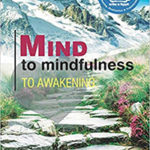
Mindfulness is not for me” In fact – everyone can practice it. Really!
Do we need a change in our day-to-day living i.e. from anxiety, anger, agitation, fatigue, disturbed sleep, distractions, reactions, and stress? Then we need to practice it for relaxation, calm, and peace; enhanced awareness and attention; improved concentration, memory, retention; increased performance and productivity; work-life balance.
One needs to think and reflect upon the journey of life to move in the right direction. The right direction in life needs the right speech, right speech, and right action 24X7. They all emanate from the mind. The journey to mindfulness helps the mind to live, and work in the right perspective at all times. Therefore, mindfulness is for everyone.
Mindfulness is for everyone
Most remarkable technologies were discovered by Christians, does not mean, they are religious. Mindfulness is the technology created by great masters of eastern wisdom free from dogma, belief, cult, and religion. In reality, it is for every human being.
We never say- breathing is not for me, let me drop it. Eating is not for me, let me stop eating. Similarly the case for sleeping, waking, restfulness, calmness, peace, and happiness. In the same way, masters of eastern wisdom say that having a mind is not enough, understanding its nature, states, levels to evolve, to live a life beyond suffering are more important. Hence mindfulness/meditation is for everyone
Because mindfulness is effortless and natural i.e. state of mind, it is for everyone. Because it helps the mind to change the brain to change our habits and attitudes, it is for everyone. Because it is not a habit but a discovery where the mind transitions from practice to non-practice (effortless and natural), it is for everyone. We eat food but never digest, assimilate, and absorb it. Similarly, we need to practice it and continue the journey until the mind naturally lives in the mindfulness state.
येषां न विद्या न तपो न दानं, ज्ञानं न शीलं न गुणो न धर्मः ।
ते मर्त्यलोके भुवि भारभूता, मनुष्यरूपेण मृगाश्चरन्ति ॥
yeShAM na vidyA na tapo na dAnaM jnAnaM na shIlaM na guNo na dharmaH ।
te martyaloke bhuvi bhAraBUtA manuShyarUpeNa mRugAshcharanti ॥
Those who are not awakened, who do not do live with patience and tolerance, does no charity (of knowledge), do not acquire knowledge (of self), do not have noble qualities ( of kindness, peace, truth), not even good qualities, do not follow the essential nature ( realself) are animals walking on this earth in human form. They are only a burden on the planet.
Eastern wisdom uses symbolism beautifully in their verses. The above verse answers major questions – why, how, what, where and when of mindfulness.
Working on the mind, changes the animal mind (also the cause of suffering). Discovery of essential nature awakens one to inner peace, happiness, love and wisdom. The knowledge of the self destroys ignorance from life and manifests noble qualities, positive attitudes, patience, kindness, happiness and wisdom.
Simple steps to practice mindfulness
When goal of meditation/ mindfulness is clear in the mind, every step can help reach, every condition is an opportunity to work for it, anytime can become a part of journey and every act become a step towards awakening. But when goal is not clear, departure point is unknown, and mind still is working on us, then years of practice fails us.
The reality behind body, mind, life is only one. It is our true nature or essential nature. The acquired nature works in the world of change i.e. people, place, objects, events and time. We are present in time, but time may change. We are present in the presence or absence of people, place and possession. It is this presence or real-self or consciousness.
When mind is not clear about the goal, covered by veil of ignorance (incomplete knowledge about our real nature, world, existence), it identifies with millions of things and events. The identification causes desire to exist, the desire causes agitation. The agitation may become aspiration to know our own nature. In the case of mental impurity and clarity, many steps have been discovered and perfected by masters. Awareness of breath, sensation, thoughts, feelings , non-self , mantra, asana , pranayama, mudra, are few of the practices incorporated as step towards awakening. It is important to remember that these practices or steps are like means not the end like car is a mean to reach home. At some time, we must leave the car behind. We need not to remain attached to the car, otherwise, we will reach inside home.
Every master for 6000 years followed the same principles of eastern wisdom but gave different practices to their contemporary’s people. It is because of the temperament of people. We are living in an age of reason, the principles of eastern wisdom are much more relevant in today’s world because we can intellectually understand before starting the practice. This approach is common in all our activities in daily life.
The external factors like choosing position of body (lying, sitting or any other depending on the condition of the body), place (private place or studio or office), fragrance, sound, etc. are secondary, and may be important in the beginning but not essential.
The internal factors like level of awareness of the body, breath, thinking, sensations are much more important, still are left behind in mindfulness state because emptiness or objectless state is more important than these experiences.
The objectless state is the state where experience and experiencer meets together and separate from each other. The mindfulness is knowing the experiencer. That is why buddha said, know thyself, he did not say- know thy experiences.


